
By Tim Kelly
When you live in a dollhouse, you have to make some adjustments.
“You must simplify what you need,” said Laurie Nadolny, the longest tenured resident of one of Ocean City’s hidden gems, the tiny neighborhood known as “Dollhouse Row.”
“You quickly learn that things aren’t so important.”
Nine miniature homes are crammed along Wovern Place, a tiny thorofare many residents and most visitors assume is an alley—if they know it exists at all.
The narrow, winding stretch of asphalt is a contradiction: secluded from crowds and through traffic while residents are seemingly on top of each other, in homes situated just six feet apart.
The result for those who live here is a mixture of quiet and closeness. Whomever said “good fences make good neighbors” surely was not speaking about Dollhouse Row.
“In summer you have to keep your voice down and (watch what you say) because you hear what everyone is talking about,” said Nadolny, who has resided for 21 years in the meticulously maintained and decorated dollhouse she shares with husband Rick Derr.
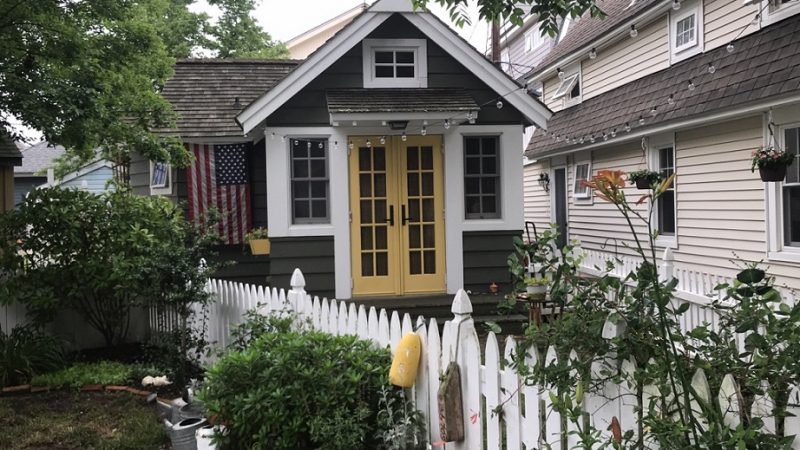
Exterior of two of the miniature homes on Wovern Street
They are also among the few year-round residents on the street. “It’s very quiet in the off-season, but even in season it’s pretty quiet,” she said.
What Dollhouse Row lacks in noise and crowds, it makes up in history and charm. Situated more than a mile from the official Historic District, Wovern Place is arguably among the most historic streets on the island.
It’s hard to imagine Ocean City’s past as a sleepy resort town almost anywhere on the island, including the Historic District. But a stroll along the quaint stretch of tiny homes will definitely take you back.
The first appearance of a dollhouse lot on a city map was in 1919, according to Cape May County records. The lot, which is identified as 1426 Wovern Place is now the fourth house on the nine-house row.
That particular city map was also the first one to include the street. Prior maps depicted “an open, undeveloped area,” said Noel Wirth of the Ocean City Historical Museum. She said many people believe the homes were originally built as fishing cottages.
County records show that first lot changed hands three times before eight of the nine dollhouses were constructed in 1927. Wirth said documents indicate Albert and Margaret Henry sold the lot to Ellis Scull, who in turn sold it to Max Zimmerman in 1924.
It was not immediately known if Scull was a member of the extended family that played a large role in the history of the Scullville section of Egg Harbor Twp.
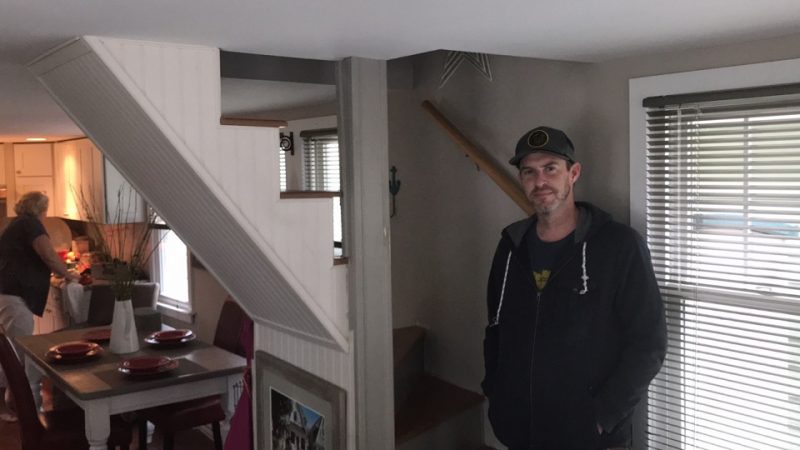
Rob Nadolny, 41, visiting from Charleston, South Carolina, stands beside the stairs in his mother and stepfather’s Ocean City “dollhouse.”
Some of the homes have been altered over the years, but most have a footprint that is 10 feet wide and 22 feet long. Nadolny’s is what she calls a “hybrid” with an addition to the original house, extending the footprint approximately 15 feet. The upgrade enabled Nadolny and Derr to add a small front porch, a kitchen larger than most along the row, a second full bedroom on the second floor and to a rooftop deck off the “master bedroom.”
Another home, owned by Tina Martin and Lynne Berry is the largest, with a raised roof and an extension to the house which lengthened it to 44 feet and pushed its overall size just past the 800 square ft. mark.
But make no mistake, the house is small.
“Each room and each area of the house has to do more than one thing,” Berry said. For example, a circular table and seating just off the kitchen creates “a second living room,” Berry said. “It’s an area where you can relax and read a book, but it will (accommodate) my total of 10 grandchildren and great-grandchildren,” she said.
Along with the occasional adjustments come some real practical advantages to living in the small homes, residents say. The dwellings use much smaller amounts of electricity than conventional homes, “mowing the lawn” amounts to a couple swipes with a push mower, and shoveling snow is a five minute chore.
The homes are reminiscent of Cape May’s many “gingerbread” houses, but in miniature, with sharply peaked roofs, flower boxes and strings of decorative lights. Residents have added shore-themed decorations, and touches like bright paint, awnings and cosmetic landscaping to provide individual identities to the homes.
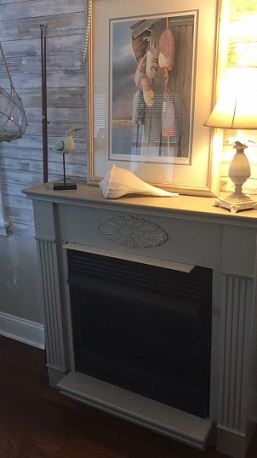
Fireplace in living room of a Wovern Street “dollhouse.”
Similar in style and size, Nadolny says the identity of the architect has been lost to history. Another mystery is the origin of the Wovern Place street name. None of the early residents of the houses had that surname, Berry said.
When Nadolny moved here in the 90s, many of the homes were in need of some TLC. Martin and Berry’s, purchased in 2008, was largely gutted. The “popcorn” ceiling was removed to expose the original beams. Rooms were opened up and trees were planted outside.
“It was as if previous owners wanted the house to be as nondescript as possible,” Berry said. “We wanted it to have a personality.”
Several other dollhouses along the row changed hands in the first few years after Nadolny and Derr bought in, but only one has sold in the last 10 years, Martin said. Another was for sale earlier this year but was recently pulled off the market.
A few other tiny homes can be found in the blocks surrounding Wovern Place. This supports Nadolny’s contention that in the 1920s, a section of town was targeted for development of several more blocks of mini-homes. That never took place, leaving Dollhouse Row as an aberration among today’s Ocean City norm of duplexes and mini-mansions.
That is not to say that Dollhouse Row is immune to development and other changes OC has gone through. Some of the owners now rent out their dollhouses in season. A stand of old trees which served as a buffer between the homes and Prospect Place, the next street to the East, was removed a few years ago. And a block of large homes was constructed along Pleasure Avenue.
“Before (construction of the homes on Pleasure) the alley (behind the dollhouses) was just a dirt path. You didn’t need air conditioning,” Nadolny said. “But now we are somewhat cut off from the breeze and it can be uncomfortable” on the hottest days without air conditioning.

Exterior of two of the miniature homes on Wovern Street.
The homes were originally built with yellow pine wood floors, no insulation and clapboard exteriors, she said. Electric baseboard heaters keep things warm in winter if the fireplaces in the homes are not used. But almost all of the homes have been upgraded with new siding, larger windows and upgraded plumbing.
“The houses are still very basic and utilitarian,” Nadolny said, and that’s the way she and the other residents like it. Even if that means taking steps others with larger homes never need to think about.
“I keep a storage unit and we switch out our winter and summer clothes.”
Nadolny’s cottage does not have any closets. If the garment doesn’t fit in a chest of drawers or a coat rack, it’s just not going to be in the house. Obviously furniture must be small enough to fit and strategically located so as not to create a space too cramped to move about, she said.
Most of the dollhouses have galley-style kitchens and one small bathroom.
And while living in a dollhouse can present some challenges, it’s never too close for comfort, residents assert.
The residents are friendly and close in a communal sense and not just close in proximity.
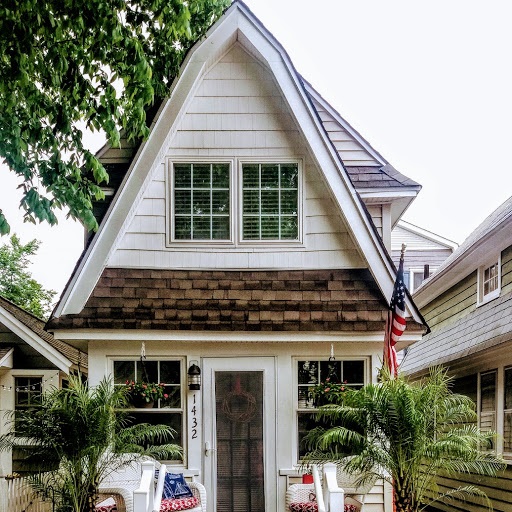
“It’s an enclave, and one that’s nice to be a part of,” said Berry.
On the weekends in summer and during prime vacation weeks, tourists will seek out the street, resulting in increased vehicular and bicycle traffic. But the residents don’t mind.
Almost all of the visitors are respectful and friendly, Nadolny said, and the majority of the dollhouse dwellers are OK with being stared at by the visitors.
“It’s also a good idea sometimes to keep your curtains drawn.”
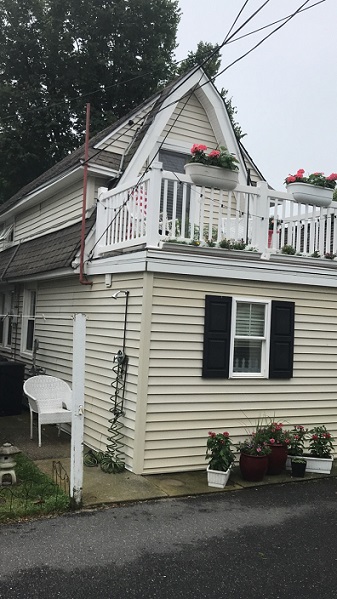
Rear view of Nadolny’s home shows the deck off her bedroom.
 By Tim Kelly
When you live in a dollhouse, you have to make some adjustments.
“You must simplify what you need,” said Laurie Nadolny, the longest tenured resident of one of Ocean City’s hidden gems, the tiny neighborhood known as “Dollhouse Row.”
“You quickly learn that things aren’t so important.”
Nine miniature homes are crammed along Wovern Place, a tiny thorofare many residents and most visitors assume is an alley—if they know it exists at all.
The narrow, winding stretch of asphalt is a contradiction: secluded from crowds and through traffic while residents are seemingly on top of each other, in homes situated just six feet apart.
The result for those who live here is a mixture of quiet and closeness. Whomever said “good fences make good neighbors” surely was not speaking about Dollhouse Row.
“In summer you have to keep your voice down and (watch what you say) because you hear what everyone is talking about,” said Nadolny, who has resided for 21 years in the meticulously maintained and decorated dollhouse she shares with husband Rick Derr.
By Tim Kelly
When you live in a dollhouse, you have to make some adjustments.
“You must simplify what you need,” said Laurie Nadolny, the longest tenured resident of one of Ocean City’s hidden gems, the tiny neighborhood known as “Dollhouse Row.”
“You quickly learn that things aren’t so important.”
Nine miniature homes are crammed along Wovern Place, a tiny thorofare many residents and most visitors assume is an alley—if they know it exists at all.
The narrow, winding stretch of asphalt is a contradiction: secluded from crowds and through traffic while residents are seemingly on top of each other, in homes situated just six feet apart.
The result for those who live here is a mixture of quiet and closeness. Whomever said “good fences make good neighbors” surely was not speaking about Dollhouse Row.
“In summer you have to keep your voice down and (watch what you say) because you hear what everyone is talking about,” said Nadolny, who has resided for 21 years in the meticulously maintained and decorated dollhouse she shares with husband Rick Derr.
 Exterior of two of the miniature homes on Wovern Street
They are also among the few year-round residents on the street. “It’s very quiet in the off-season, but even in season it’s pretty quiet,” she said.
What Dollhouse Row lacks in noise and crowds, it makes up in history and charm. Situated more than a mile from the official Historic District, Wovern Place is arguably among the most historic streets on the island.
It’s hard to imagine Ocean City’s past as a sleepy resort town almost anywhere on the island, including the Historic District. But a stroll along the quaint stretch of tiny homes will definitely take you back.
The first appearance of a dollhouse lot on a city map was in 1919, according to Cape May County records. The lot, which is identified as 1426 Wovern Place is now the fourth house on the nine-house row.
That particular city map was also the first one to include the street. Prior maps depicted “an open, undeveloped area,” said Noel Wirth of the Ocean City Historical Museum. She said many people believe the homes were originally built as fishing cottages.
County records show that first lot changed hands three times before eight of the nine dollhouses were constructed in 1927. Wirth said documents indicate Albert and Margaret Henry sold the lot to Ellis Scull, who in turn sold it to Max Zimmerman in 1924.
It was not immediately known if Scull was a member of the extended family that played a large role in the history of the Scullville section of Egg Harbor Twp.
Exterior of two of the miniature homes on Wovern Street
They are also among the few year-round residents on the street. “It’s very quiet in the off-season, but even in season it’s pretty quiet,” she said.
What Dollhouse Row lacks in noise and crowds, it makes up in history and charm. Situated more than a mile from the official Historic District, Wovern Place is arguably among the most historic streets on the island.
It’s hard to imagine Ocean City’s past as a sleepy resort town almost anywhere on the island, including the Historic District. But a stroll along the quaint stretch of tiny homes will definitely take you back.
The first appearance of a dollhouse lot on a city map was in 1919, according to Cape May County records. The lot, which is identified as 1426 Wovern Place is now the fourth house on the nine-house row.
That particular city map was also the first one to include the street. Prior maps depicted “an open, undeveloped area,” said Noel Wirth of the Ocean City Historical Museum. She said many people believe the homes were originally built as fishing cottages.
County records show that first lot changed hands three times before eight of the nine dollhouses were constructed in 1927. Wirth said documents indicate Albert and Margaret Henry sold the lot to Ellis Scull, who in turn sold it to Max Zimmerman in 1924.
It was not immediately known if Scull was a member of the extended family that played a large role in the history of the Scullville section of Egg Harbor Twp.
 Rob Nadolny, 41, visiting from Charleston, South Carolina, stands beside the stairs in his mother and stepfather’s Ocean City “dollhouse.”
Some of the homes have been altered over the years, but most have a footprint that is 10 feet wide and 22 feet long. Nadolny’s is what she calls a “hybrid” with an addition to the original house, extending the footprint approximately 15 feet. The upgrade enabled Nadolny and Derr to add a small front porch, a kitchen larger than most along the row, a second full bedroom on the second floor and to a rooftop deck off the “master bedroom.”
Another home, owned by Tina Martin and Lynne Berry is the largest, with a raised roof and an extension to the house which lengthened it to 44 feet and pushed its overall size just past the 800 square ft. mark.
But make no mistake, the house is small.
“Each room and each area of the house has to do more than one thing,” Berry said. For example, a circular table and seating just off the kitchen creates “a second living room,” Berry said. “It’s an area where you can relax and read a book, but it will (accommodate) my total of 10 grandchildren and great-grandchildren,” she said.
Along with the occasional adjustments come some real practical advantages to living in the small homes, residents say. The dwellings use much smaller amounts of electricity than conventional homes, “mowing the lawn” amounts to a couple swipes with a push mower, and shoveling snow is a five minute chore.
The homes are reminiscent of Cape May’s many “gingerbread” houses, but in miniature, with sharply peaked roofs, flower boxes and strings of decorative lights. Residents have added shore-themed decorations, and touches like bright paint, awnings and cosmetic landscaping to provide individual identities to the homes.
Rob Nadolny, 41, visiting from Charleston, South Carolina, stands beside the stairs in his mother and stepfather’s Ocean City “dollhouse.”
Some of the homes have been altered over the years, but most have a footprint that is 10 feet wide and 22 feet long. Nadolny’s is what she calls a “hybrid” with an addition to the original house, extending the footprint approximately 15 feet. The upgrade enabled Nadolny and Derr to add a small front porch, a kitchen larger than most along the row, a second full bedroom on the second floor and to a rooftop deck off the “master bedroom.”
Another home, owned by Tina Martin and Lynne Berry is the largest, with a raised roof and an extension to the house which lengthened it to 44 feet and pushed its overall size just past the 800 square ft. mark.
But make no mistake, the house is small.
“Each room and each area of the house has to do more than one thing,” Berry said. For example, a circular table and seating just off the kitchen creates “a second living room,” Berry said. “It’s an area where you can relax and read a book, but it will (accommodate) my total of 10 grandchildren and great-grandchildren,” she said.
Along with the occasional adjustments come some real practical advantages to living in the small homes, residents say. The dwellings use much smaller amounts of electricity than conventional homes, “mowing the lawn” amounts to a couple swipes with a push mower, and shoveling snow is a five minute chore.
The homes are reminiscent of Cape May’s many “gingerbread” houses, but in miniature, with sharply peaked roofs, flower boxes and strings of decorative lights. Residents have added shore-themed decorations, and touches like bright paint, awnings and cosmetic landscaping to provide individual identities to the homes.

 Exterior of two of the miniature homes on Wovern Street.
The homes were originally built with yellow pine wood floors, no insulation and clapboard exteriors, she said. Electric baseboard heaters keep things warm in winter if the fireplaces in the homes are not used. But almost all of the homes have been upgraded with new siding, larger windows and upgraded plumbing.
“The houses are still very basic and utilitarian,” Nadolny said, and that’s the way she and the other residents like it. Even if that means taking steps others with larger homes never need to think about.
“I keep a storage unit and we switch out our winter and summer clothes.”
Nadolny’s cottage does not have any closets. If the garment doesn’t fit in a chest of drawers or a coat rack, it’s just not going to be in the house. Obviously furniture must be small enough to fit and strategically located so as not to create a space too cramped to move about, she said.
Most of the dollhouses have galley-style kitchens and one small bathroom.
And while living in a dollhouse can present some challenges, it’s never too close for comfort, residents assert.
The residents are friendly and close in a communal sense and not just close in proximity.
Exterior of two of the miniature homes on Wovern Street.
The homes were originally built with yellow pine wood floors, no insulation and clapboard exteriors, she said. Electric baseboard heaters keep things warm in winter if the fireplaces in the homes are not used. But almost all of the homes have been upgraded with new siding, larger windows and upgraded plumbing.
“The houses are still very basic and utilitarian,” Nadolny said, and that’s the way she and the other residents like it. Even if that means taking steps others with larger homes never need to think about.
“I keep a storage unit and we switch out our winter and summer clothes.”
Nadolny’s cottage does not have any closets. If the garment doesn’t fit in a chest of drawers or a coat rack, it’s just not going to be in the house. Obviously furniture must be small enough to fit and strategically located so as not to create a space too cramped to move about, she said.
Most of the dollhouses have galley-style kitchens and one small bathroom.
And while living in a dollhouse can present some challenges, it’s never too close for comfort, residents assert.
The residents are friendly and close in a communal sense and not just close in proximity.
 “It’s an enclave, and one that’s nice to be a part of,” said Berry.
On the weekends in summer and during prime vacation weeks, tourists will seek out the street, resulting in increased vehicular and bicycle traffic. But the residents don’t mind.
Almost all of the visitors are respectful and friendly, Nadolny said, and the majority of the dollhouse dwellers are OK with being stared at by the visitors.
“It’s also a good idea sometimes to keep your curtains drawn.”
“It’s an enclave, and one that’s nice to be a part of,” said Berry.
On the weekends in summer and during prime vacation weeks, tourists will seek out the street, resulting in increased vehicular and bicycle traffic. But the residents don’t mind.
Almost all of the visitors are respectful and friendly, Nadolny said, and the majority of the dollhouse dwellers are OK with being stared at by the visitors.
“It’s also a good idea sometimes to keep your curtains drawn.”
 Rear view of Nadolny’s home shows the deck off her bedroom.
Rear view of Nadolny’s home shows the deck off her bedroom.